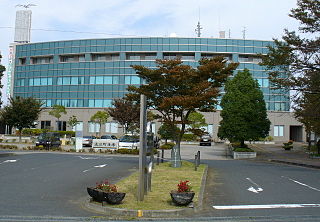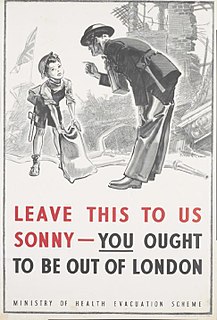Related Research Articles

Civil defence or civil protection is an effort to protect the citizens of a state from natural disasters. It uses the principles of emergency operations: prevention, mitigation, preparation, response, or emergency evacuation and recovery. Programs of this sort were initially discussed at least as early as the 1920s and were implemented in some countries during the 1930s as the threat of war and aerial bombardment grew. It became widespread after the threat of nuclear weapons was realized.

Nuclear warfare is a military conflict or political strategy which deploys nuclear weaponry. Nuclear weapons are weapons of mass destruction; in contrast to conventional warfare, nuclear warfare can produce destruction in a much shorter time and can have a long-lasting radiological result. A major nuclear exchange would have long-term effects, primarily from the fallout released, and could also lead to a "nuclear winter" that could last for decades, centuries, or even millennia after the initial attack. Some analysts dismiss the nuclear winter hypothesis, and calculate that even with nuclear weapon stockpiles at Cold War highs, although there would be billions of casualties, billions more rural people would nevertheless survive. However, others have argued that secondary effects of a nuclear holocaust, such as nuclear famine and societal collapse, would cause almost every human on Earth to starve to death.

Nuclear fallout is the residual radioactive material propelled into the upper atmosphere following a nuclear blast, so called because it "falls out" of the sky after the explosion and the shock wave has passed. It commonly refers to the radioactive dust and ash created when a nuclear weapon explodes. The amount and spread of fallout is a product of the size of the weapon and the altitude at which it is detonated. Fallout may get entrained with the products of a pyrocumulus cloud and fall as black rain. This radioactive dust, usually consisting of fission products mixed with bystanding atoms that are neutron-activated by exposure, is a form of radioactive contamination.

The Nevada National Security Site, known as the Nevada Test Site (NTS) until 2010, is a United States Department of Energy (DOE) reservation located in southeastern Nye County, Nevada, about 65 miles (105 km) northwest of the city of Las Vegas. Formerly known as the Nevada Proving Grounds, the site was established in 1951 for the testing of nuclear devices. It covers approximately 1,360 square miles (3,500 km2) of desert and mountainous terrain. Nuclear weapons testing at the site began with a 1-kiloton-of-TNT (4.2 TJ) bomb dropped on Frenchman Flat on January 27, 1951. Over the subsequent four decades, over 1,000 nuclear explosions were detonated at the site. Many of the iconic images of the nuclear era come from the site.

Chemical, biological, radiological and nuclear defence are protective measures taken in situations in which chemical, biological, radiological or nuclear warfare hazards may be present. CBRN defence consists of CBRN passive protection, contamination avoidance and CBRN mitigation.

"Duck and cover" is a method of personal protection against the effects of a nuclear explosion. Ducking and covering is useful at conferring a degree of protection to personnel located outside the radius of the nuclear fireball but still within sufficient range of the nuclear explosion that standing upright and uncovered is likely to cause serious injury or death. In the most literal interpretation, the focus of the maneuver is primarily on protective actions one can take during the first few crucial seconds-to-minutes after the event, while the film by the same name and a full encompassing of the advice, also caters to providing protection up to weeks after the event.

Namie is a town located in Fukushima Prefecture, Japan. As of 29 February 2020 the town has a population of 1238 in 794 households, although the official registered population was 17,114 in 6853 households. The total area of the town is 223.14 square kilometres (86.15 sq mi). The town was evacuated as a result of the Fukushima Daiichi nuclear disaster—being directly downwind from the power plant—and was within the exclusion zone set up in response to the disaster. Following ongoing clean-up efforts, Namie's business district and town hall have reopened, but access to more heavily contaminated western parts of the town remains restricted.

The evacuation of civilians in Britain during the Second World War was designed to protect people, especially children, from the risks associated with aerial bombing of cities by moving them to areas thought to be less at risk.

Emergency evacuation is the urgent immediate egress or escape of people away from an area that contains an imminent threat, an ongoing threat or a hazard to lives or property.

The United States was the first country to manufacture nuclear weapons and is the only country to have used them in combat, with the separate bombings of Hiroshima and Nagasaki in World War II. Before and during the Cold War, it conducted over one thousand nuclear tests and tested many long-range nuclear weapons delivery systems.
Operation Sassoon provides a basic generic framework for an emergency evacuation plan of any part of London, or Heathrow, in the case of a major terrorist attack in the British capital. It is part of an extensive anti-terror plan installed by the British Government in response to the rising threat of terrorist attacks in the United Kingdom. The plan, first drawn up in 2003, oversees the partial or complete evacuation of the inner parts of London after either a large-scale assault affecting a larger area of the city or an event having a lasting effect over a longer period of time, such as a biological, chemical or nuclear attack. Besides the actual evacuation process, Operation Sassoon covers the principles of largescale evacuation, the installation of temporary shelters for evacuees in assigned areas outside the city, activation of the plan and the roles and responsibilities of agencies under the plan, as well as the deployment of police and military forces for maintaining civil order after a major attack has occurred.

Nuclear safety is defined by the International Atomic Energy Agency (IAEA) as "The achievement of proper operating conditions, prevention of accidents or mitigation of accident consequences, resulting in protection of workers, the public and the environment from undue radiation hazards". The IAEA defines nuclear security as "The prevention and detection of and response to, theft, sabotage, unauthorized access, illegal transfer or other malicious acts involving nuclear materials, other radioactive substances or their associated facilities".

United States civil defense refers to the use of civil defense in the history of the United States, which is the organized non-military effort to prepare Americans for military attack. Late in the 20th century, the term and practice of civil defense fell into disuse. Emergency management and homeland security replaced them.

The history of Chico, California, begins with the original inhabitants, the Mechoopda Maidu.

Hurricane evacuation is the immediate and rapid movement of people away from the threat or actual occurrence of a hurricane. County judges, emergency managers and other officials may recommend a voluntary evacuation or order a mandatory evacuation.
The Los Angeles County Civil Defense and Disaster Commission is a nine-member panel created in 1961 to prepare for the threat of nuclear war, in addition to the perennial Los Angeles County concerns of flooding, landslides, fires, and earthquakes.

The Japanese reaction occurred after the Fukushima Daiichi nuclear disaster, following the 2011 Tōhoku earthquake and tsunami. A nuclear emergency was declared by the government of Japan on 11 March. Later Prime Minister Naoto Kan issued instructions that people within a 20 km (12 mi) zone around the Fukushima Daiichi nuclear plant must leave, and urged that those living between 20 km and 30 km from the site to stay indoors. The latter groups were also urged to evacuate on 25 March.
Many countries around the world have civil defense organizations dedicated to protecting civilians from military attacks and providing rescue services after widespread disasters. In most countries, civil defense is a government-managed and often volunteer-staffed organization.

The COVID-19 pandemic coincided with record-breaking wildfires in the western United States and a record number of hurricane landfalls in the southeastern United States. Emergency evacuation may be required for people living in areas threatened by natural disasters. Historic procedures maximizing capacity of public transport and emergency shelters may be inconsistent with quarantine and physical distancing measures related to the COVID-19 pandemic. It is not advisable to set up congregate shelters in an environment heavily impacted by a pandemic. Non-congregate shelters typically provide more effective physical distancing. Examples include buildings with single room occupancy, hotels or dormitories with private sleeping spaces but possibly shared bathroom or cooking facilities. Thousands of evacuees from Hurricane Laura were still in emergency lodgings as Hurricane Delta approached the Louisiana coast. Six-thousand from southwest Louisiana were in twelve New Orleans area hotels. Three-thousand-five-hundred remained in shelters as Hurricane Zeta approached Louisiana. A volcanic eruption on the island of Saint Vincent in April 2021 caused evacuation of sixteen-thousand people. Four-thousand evacuees were placed in eighty-nine government shelters after being tested for COVID-19, with those testing positive taken to isolation centers. Six-thousand evacuees found shelter in private homes.
References
- 1 2 3 Operation Chico was only a test
- ↑ News From Our Past, Chico ER, 6 Dec 2008